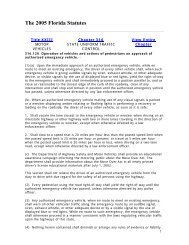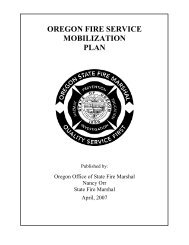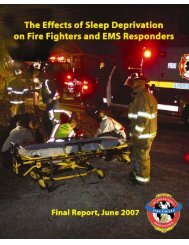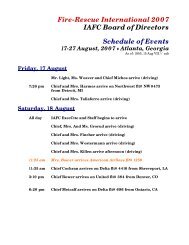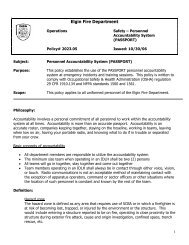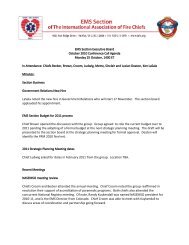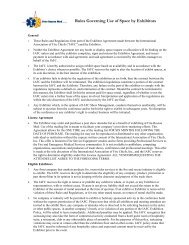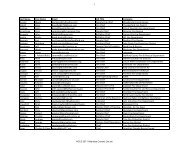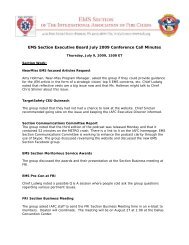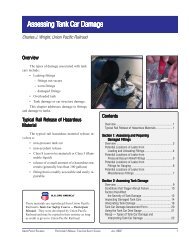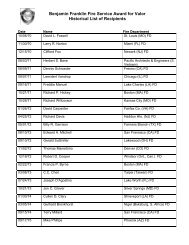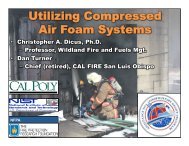Competency-Based Learning in the Fire Service.pptm
Competency-Based Learning in the Fire Service.pptm
Competency-Based Learning in the Fire Service.pptm
Create successful ePaper yourself
Turn your PDF publications into a flip-book with our unique Google optimized e-Paper software.
<strong>Competency</strong>-<strong>Based</strong> <strong>Learn<strong>in</strong>g</strong> <strong>in</strong><br />
<strong>the</strong> <strong>Fire</strong> <strong>Service</strong><br />
Michael A. Wieder, MS, CFPS, MI<strong>Fire</strong>E<br />
Assistant Director, IFSTA/<strong>Fire</strong> Protection<br />
Publications<br />
Oklahoma State University
Our Objectives For Today<br />
• Highlight <strong>the</strong> two approaches to<br />
teach<strong>in</strong>g<br />
• Detail <strong>the</strong> concepts of competency-<br />
based learn<strong>in</strong>g (CBL)<br />
• Show how CBL is used <strong>in</strong> <strong>the</strong> fire<br />
service<br />
• Discuss approaches to student<br />
assessment
Two Basic Approaches to<br />
Teach<strong>in</strong>g<br />
• Traditional<br />
• Mastery
The Traditional Approach<br />
• <strong>Based</strong> on <strong>the</strong><br />
presentation of<br />
<strong>in</strong>formation through<br />
lectures, read<strong>in</strong>gs, and<br />
audiovisuals<br />
• Best used for <strong>the</strong>ory or<br />
concepts<br />
• Not conducive to<br />
psychomotor skills<br />
tra<strong>in</strong><strong>in</strong>g
Key Concepts of Traditional Teach<strong>in</strong>g<br />
• Concept-based<br />
–<br />
Set topics that <strong>the</strong><br />
student must know<br />
• Time-based<br />
– Time<br />
is set, regardless of<br />
learn<strong>in</strong>g speed<br />
• Group-based<br />
–<br />
Teach<strong>in</strong>g is based on<br />
<strong>the</strong> average student<br />
• Instructor-<br />
dependent – The<br />
primary resource for<br />
<strong>the</strong> student<br />
• General Goals<br />
• Norm-referenced<br />
referenced<br />
assessments –<br />
Success based on <strong>the</strong><br />
class average
The Mastery Approach<br />
• Def<strong>in</strong>ed – A high-level<br />
or nearly complete<br />
degree of proficiency <strong>in</strong><br />
<strong>the</strong> execution of a skill.<br />
• Formerly called<br />
<strong>Competency</strong>-<strong>Based</strong><br />
Tra<strong>in</strong><strong>in</strong>g (CBT)<br />
• Now referred to as<br />
<strong>Competency</strong>-<strong>Based</strong><br />
<strong>Learn<strong>in</strong>g</strong> (CBL)
Characteristics of CBL<br />
• <strong>Competency</strong>-based<br />
– Focused<br />
on <strong>the</strong> accurate completion of<br />
skills<br />
• Performance-based<br />
– Success<br />
determ<strong>in</strong>ed by student<br />
performance<br />
• Individual-based<br />
– Can be<br />
tailored to meet <strong>in</strong>dividual needs
Characteristics of CBL<br />
• Immediate feedback – As<br />
soon as <strong>the</strong> student performs<br />
<strong>the</strong> skill<br />
supported – The<br />
<strong>in</strong>structor helps <strong>the</strong> student<br />
learn <strong>the</strong> skill<br />
Specific-objectives<br />
– To<br />
reach <strong>the</strong> f<strong>in</strong>al course goal<br />
• Instructor-supported<br />
– The<br />
• Specific-objectives – To<br />
• Criterion-referenced<br />
referenced<br />
assessments – Set at a<br />
specific level, usually 70-100%
The Key to Effective CBL<br />
• You must have properly constructed,<br />
performance-based learn<strong>in</strong>g<br />
objectives!<br />
• They must be based on a standard of<br />
expected performance.<br />
• In <strong>the</strong> fire service we generally use<br />
NFPA Professional Qualifications<br />
standards (e.g. NFPA 1001 or 1021)
Not A Good Example of a <strong>Learn<strong>in</strong>g</strong><br />
Objective…<br />
• 3-9.6<br />
– Identify <strong>the</strong><br />
types of tools used<br />
dur<strong>in</strong>g ventilation.<br />
(NFPA 1001, 1992 edition)<br />
• Is this what we really<br />
want <strong>the</strong>m to<br />
accomplish?<br />
• How do we measure<br />
this fairly?
Job Performance Requirements<br />
• NFPA Pro Qual standards<br />
have used <strong>the</strong>se s<strong>in</strong>ce 1993<br />
• Standards are organized by<br />
major duties<br />
• Duties are broken down<br />
<strong>in</strong>to JPRs<br />
• JPRs are broken down <strong>in</strong>to<br />
specific learn<strong>in</strong>g objectives
Components of a JPR<br />
• Classic Terms<br />
• Behavior<br />
• Conditions<br />
• Degree<br />
• NFPA Term<strong>in</strong>ology<br />
• Tasks<br />
• Tools (“givens”)<br />
• Evaluation<br />
parameters and/or<br />
performance<br />
outcomes (“so(<br />
thats”)
Foundations of <strong>the</strong> JPR<br />
• Requisite<br />
knowledge and<br />
requisite skills<br />
• Knowledge and<br />
skills one must<br />
have prior to<br />
be<strong>in</strong>g able to<br />
perform <strong>the</strong><br />
task
A Corny Example<br />
• Your spouse asks you to help with<br />
d<strong>in</strong>ner by cook<strong>in</strong>g a can of corn<br />
• A seem<strong>in</strong>gly simple task…<br />
• Cook a can of corn…
What do we need to accomplish<br />
this?<br />
• A can of corn<br />
• A can opener<br />
• One pot with lid<br />
• A cook<strong>in</strong>g appliance<br />
• A serv<strong>in</strong>g spoon<br />
• A serv<strong>in</strong>g dish<br />
• A trivet or hot pad
How do we know we are done?<br />
• The can has been opened and discarded<br />
• The corn simmers <strong>in</strong> <strong>the</strong> pot for 10<br />
m<strong>in</strong>utes<br />
• The corn is stirred at least twice<br />
• The appliance is turned off<br />
• The corn is transferred to <strong>the</strong> serv<strong>in</strong>g bowl<br />
• The bowl is placed on <strong>the</strong> hot pad, on <strong>the</strong><br />
table, with a spoon
Foundations for this Task…<br />
• Requisite Skills<br />
• Operation of a can<br />
opener<br />
• Operation of <strong>the</strong><br />
cook<strong>in</strong>g appliance<br />
• Ability to stir<br />
vegetables<br />
• Requisite Knowledge<br />
• Where <strong>the</strong> corn is<br />
stored<br />
• Characteristics of<br />
simmer<strong>in</strong>g<br />
• Manufacturer’s<br />
operat<strong>in</strong>g<br />
<strong>in</strong>structions for can<br />
opener and stove
How it looks as a JPR…<br />
Cook a can of corn, given a can of corn, a<br />
can opener, a pot with lid, a cook<strong>in</strong>g<br />
appliance, a serv<strong>in</strong>g spoon, a serv<strong>in</strong>g dish,<br />
and a trivet or hot pad, so that <strong>the</strong> can is<br />
opened, <strong>the</strong> empty can is discarded, <strong>the</strong> corn<br />
simmers <strong>in</strong> <strong>the</strong> pot for 10 m<strong>in</strong>utes, <strong>the</strong> corn<br />
is stirred twice dur<strong>in</strong>g <strong>the</strong> simmer period,<br />
<strong>the</strong> cook<strong>in</strong>g appliance is turned off, <strong>the</strong> corn<br />
is transferred to <strong>the</strong> serv<strong>in</strong>g bowl without<br />
be<strong>in</strong>g spilled, and <strong>the</strong> serv<strong>in</strong>g bowl is placed<br />
on a hot pad on <strong>the</strong> table.
How it looks as a JPR…<br />
• Requisite Skills -<br />
Operation of a can<br />
opener; operation<br />
of <strong>the</strong> cook<strong>in</strong>g<br />
appliance; ability<br />
to stir vegetables<br />
• Requisite<br />
Knowledge -<br />
Where <strong>the</strong> corn is<br />
stored;<br />
characteristics of<br />
simmer<strong>in</strong>g;<br />
manufacturer’s<br />
operat<strong>in</strong>g<br />
<strong>in</strong>structions for can<br />
opener and stove
A Real Example<br />
5.3.7* Attack a passenger vehicle fire<br />
operat<strong>in</strong>g as a member of a team, given<br />
personal protective equipment, attack l<strong>in</strong>e,<br />
and hand tools, so that hazards are avoided,<br />
leak<strong>in</strong>g flammable liquids are identified and<br />
controlled, protection from flash fires is<br />
ma<strong>in</strong>ta<strong>in</strong>ed, all vehicle compartments are<br />
overhauled, and <strong>the</strong> fire is ext<strong>in</strong>guished.<br />
NFPA 1001, 2008 Edition
NFPA 1002 5.3.7 Requisite<br />
Knowledge<br />
Pr<strong>in</strong>ciples of fire streams as <strong>the</strong>y relate to<br />
fight<strong>in</strong>g automobile fires; precautions to be<br />
followed when advanc<strong>in</strong>g hose l<strong>in</strong>es toward<br />
an automobile; observable results that a fire<br />
stream has been properly applied;<br />
identify<strong>in</strong>g alternative fuels and <strong>the</strong> hazards<br />
associated with <strong>the</strong>m; dangerous conditions<br />
created dur<strong>in</strong>g an automobile fire; common<br />
types of accidents or <strong>in</strong>juries related to<br />
fight<strong>in</strong>g automobile fires and how to avoid<br />
<strong>the</strong>m; how to access locked passenger,<br />
trunk, and eng<strong>in</strong>e compartments; and<br />
methods for overhaul<strong>in</strong>g an automobile.
NFPA 1002 5.3.7 Requisite Skills<br />
The ability to identify automobile fuel<br />
type; assess and control fuel leaks;<br />
open, close, and adjust <strong>the</strong> flow and<br />
pattern on nozzles; apply water for<br />
maximum effectiveness while<br />
ma<strong>in</strong>ta<strong>in</strong><strong>in</strong>g flash fire protection;<br />
advance 1½-<strong>in</strong>. 1<br />
(38-mm) or larger<br />
diameter attack l<strong>in</strong>es; and expose<br />
hidden fires by open<strong>in</strong>g all automobile<br />
compartments.
Let’s s Write a JPR<br />
You pick <strong>the</strong> skill
Advantages of CBL<br />
• Students are<br />
prepared to advance<br />
to more complex<br />
knowledge or skills.<br />
• Knowledge that <strong>the</strong><br />
student possessed<br />
before <strong>the</strong> course can<br />
be used to ga<strong>in</strong><br />
mastery more<br />
quickly.
Advantages of CBL<br />
• Instructors must perform task analyses to<br />
ensure that <strong>the</strong>y are prepared to teach <strong>the</strong><br />
unit or lesson.<br />
• Instructors must state <strong>the</strong> learn<strong>in</strong>g<br />
objectives before designat<strong>in</strong>g or design<strong>in</strong>g<br />
student activities and projects.<br />
• The responsibility for learn<strong>in</strong>g is focused<br />
on <strong>the</strong> student and <strong>in</strong>creases <strong>the</strong> likelihood<br />
of success.
Disadvantages of CBL<br />
• Additional time must<br />
be available to<br />
ensure that all<br />
students master <strong>the</strong><br />
subject.<br />
• More effort is<br />
required on <strong>the</strong><br />
<strong>in</strong>structor’s s part to<br />
teach to <strong>the</strong><br />
<strong>in</strong>dividual learn<strong>in</strong>g<br />
speed of all <strong>the</strong><br />
students <strong>in</strong> <strong>the</strong> class.
Disadvantages of CBL<br />
• Faster students may feel<br />
that <strong>the</strong> slower students<br />
are hold<strong>in</strong>g <strong>the</strong>m back.<br />
• Several formative exams<br />
must be written and<br />
adm<strong>in</strong>istered dur<strong>in</strong>g <strong>the</strong><br />
course.<br />
• A wide variety of tra<strong>in</strong><strong>in</strong>g<br />
materials must be<br />
available to meet <strong>the</strong><br />
learn<strong>in</strong>g needs of all<br />
students.
Two Methods of Assessment<br />
• Norm-Referenced<br />
• Used with traditional teach<strong>in</strong>g<br />
• Scores are translated <strong>in</strong>to grades<br />
• Grades are often based on class average<br />
• Criterion-Referenced<br />
• Refers to a standard on which a<br />
judgment is based<br />
• Criteria stated <strong>in</strong> course objectives<br />
• Student is compared to <strong>the</strong> criteria, not<br />
o<strong>the</strong>r students
Criterion-Referenced Assessment<br />
• Student performance will vary, but<br />
must meet <strong>the</strong> criteria<br />
• Pass/Fail scor<strong>in</strong>g most commonly<br />
used<br />
• Pass – Performance at or above <strong>the</strong><br />
criterion<br />
• Fail – Performance below <strong>the</strong> criterion<br />
• Agency sets m<strong>in</strong>imum pass rate
Implement<strong>in</strong>g CBL In Your<br />
Department<br />
• Be committed to <strong>the</strong> process<br />
• Everyone follows <strong>the</strong> same rules<br />
• Choose NFPA standards/JPRs you<br />
wish to address<br />
• Write your own JPRs based on local<br />
needs<br />
• Be realistic <strong>in</strong> sett<strong>in</strong>g your standards<br />
• Be fair!
QUESTIONS? THANKS!!<br />
Mike Wieder, Assistant Director<br />
IFSTA/<strong>Fire</strong> Protection Publications<br />
Oklahoma State University<br />
930 North Willis Street<br />
Stillwater, OK 74078-8045<br />
8045<br />
405-744-4255<br />
4255<br />
mwieder@osufpp.org



